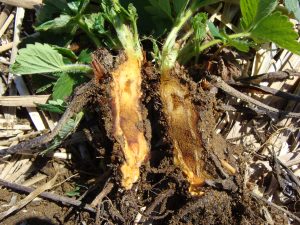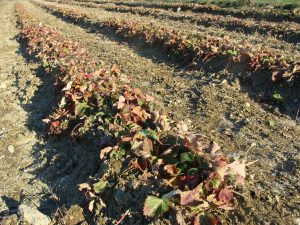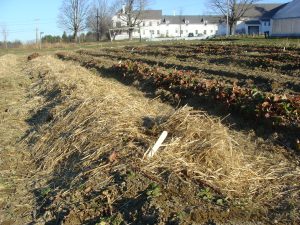Helping Your Strawberries Through the Winter

While strawberries have long been a staple of spring crops in Maine, the plants are not especially hardy. As an herbaceous, or non-woody plant, strawberries don’t achieve what is considered a true state of dormancy during the winter. Rather, they go into a quiescent state, or pseudo-dormancy which offers some protection against extreme temperatures, but not to the degree that true dormancy provides. Should the plant tissues freeze during the winter, the effects will be apparent next spring, with weakened and dead plants. How then, do these plants survive the Maine winters? The answer lies in their low growing habit. By being so close to the ground, the plants are usually covered by leaves and snow during the winter, which offers a protective blanket to keep them from being exposed to extreme cold and wide fluctuations in temperature. However, adequate snow cover is not always dependable, especially under our current climate conditions, so strawberry growers must provide additional protection each winter to insure the plants survival and success. This is accomplished by applying a protective layer of mulch over the plants each fall.
Mulch is only part of an overall strategy to successful overwintering. Before mulching, there are other steps that should be taken to prevent winter injury, beginning with site selection. Plant the beds in well–drained soils on sites that are protected from extreme winds. Only plant varieties that are known to be hardy and well adapted to this region. Also avoid applications of nitrogen fertilizer to the beds late in the season, e.g. after mid-August, as this can stimulate late, lush growth and delay quiescence. These steps will assure that the plants are ending the growing season in a healthy state, ready to face the long cold winter with the help of some properly utilized mulch.

Mulch should be applied over the beds in the late fall after the plants are quiescent, as indicated by the leaves turning reddish and collapsing down around the crowns after a few hard frosts (usually late November). Straw, from oats, rye, barley or wheat is the most commonly used mulching material. Do not use hay, because it contains weed seeds that will grow among the strawberries next spring. Be discriminating about your source of straw. Straw from weedy fields will result in weed infestations in your strawberries. Two to five tons of straw per acre is recommended (approximately one ton of straw provides one inch of coverage per acre). Use the higher rates if your fields are exposed and do not get consistent snow cover. The mulch layer should be approximately 6 inches deep over the plants. Several types of machines are available to break up straw bales and help distribute it over the beds. For plasticulture beds, fabric rowcovers are applied for protection over the beds rather than straw. While these sometimes do not offer consistent winter protection, they are much easier to work with in a plasticulture system. Covers should be applied soon after quiescence and be at least 1.25 oz. thick to provide adequate insulation. Some manufacturers offer thicker covers specifically for winter protection. Be sure the edges of the cover are adequately weighted down with sand bags, or bury the edges to prevent the wind from dislodging them.

Mulch should remain on the plants through the winter, but don’t delay its removal in the early spring. As spring approaches, be ready to remove the mulch to stimulate early growth and fruit bud development. Leaving the mulch on too long in the spring can delay emergence and reduce flower bud numbers, resulting in later and lower harvests. When other early spring plants are starting to grow, such as lilacs and tulip bulbs, strawberries are ready to begin growth as well.
Successful strawberry production in Maine depends on a growers ability to see the plants through our challenging winters. By following good growing practices, including mulching for winter protection, strawberry beds here can provide consistent, profitable crops, in spite of harsh conditions and a plant that is not all that hardy.
